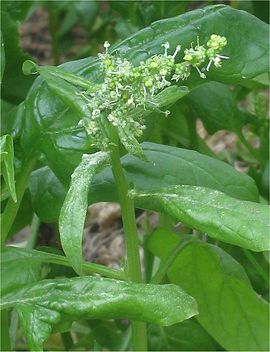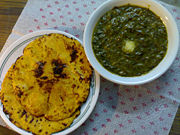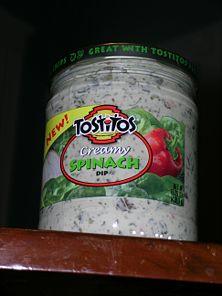Spinach
| Spinach | ||||||||||||||
|---|---|---|---|---|---|---|---|---|---|---|---|---|---|---|
 Spinach in flower
|
||||||||||||||
| Scientific classification | ||||||||||||||
|
||||||||||||||
| Binomial name | ||||||||||||||
| Spinacia oleracea L. |
| Spinach, raw Nutritional value per 100 g (3.5 oz) |
||||||||||||||||||||||||||
|---|---|---|---|---|---|---|---|---|---|---|---|---|---|---|---|---|---|---|---|---|---|---|---|---|---|---|
| Energy 20 kcal 100 kJ | ||||||||||||||||||||||||||
|
||||||||||||||||||||||||||
| Percentages are relative to US recommendations for adults. Source: USDA Nutrient database |
||||||||||||||||||||||||||
Spinach (Spinacia oleracea) is a flowering plant in the family of Amaranthaceae. It is native to central and southwestern Asia. It is an annual plant (rarely biennial), which grows to a height of up to 30 cm. Spinach may survive over winter in temperate regions. The leaves are alternate, simple, ovate to triangular-based, very variable in size from about 2-30 cm long and 1-15 cm broad, with larger leaves at the base of the plant and small leaves higher on the flowering stem. The flowers are inconspicuous, yellow-green, 3-4 mm diameter, maturing into a small hard dry lumpy fruit cluster 5-10 mm across containing several seeds.
Contents |
History
Primitive forms of spinach are found in Nepal and that is probably where the plant was first domesticated. Other than the Indian subcontinent, it was unknown in the ancient world. After the early Muslim conquests the plant spread to other areas. In 647, it was taken to China, possibly by Persians. Muslim Arabs diffused the plant westward up to Islamic Spain. By the eleventh century it was a common plant in the Muslim world.[1]
Spinach is thought to have originated in ancient Persia (Iran). Spinach made its way to China in the 7th century when the king of Nepal sent it as a gift to this country. Spinach has a much more recent history in Europe than many other vegetables. It was only brought to that continent in the 11th century, when the Moors introduced it into Spain. In fact, for a while, spinach was known as "the Spanish vegetable" in England. Spinach was the favorite vegetable of Catherine de Medici, a historical figure in the 16th century. When she left her home of Florence, Italy, to marry the king of France, she brought along her own cooks, who could prepare spinach the ways that she especially liked. Since this time, dishes prepared on a bed of spinach are referred to as "a la Florentine." [2]
Culinary Information
Nutrition
Spinach is known as a rich source of iron and calcium. According to the USDA, a 180 gram serving of boiled spinach contains 6.43 mg of iron, whereas one 6 oz. (170 gram) ground hamburger patty contains at most 4.42 mg. Thus spinach does contain a relatively high level of iron, compared to other vegetable and meat sources.[3]
Ultimately, the bioavailability of iron is dependent on its absorption. This is influenced by a number of factors. Iron enters the body in two forms: nonheme iron and heme iron. All of the iron in grains and vegetables, and about three fifths of the iron in animal food sources (meats), is nonheme iron. The much smaller remaining portion from meats is heme iron.[4]
The larger portion of dietary iron (nonheme) is absorbed slowly in its many food sources, including spinach. This absorption may vary widely depending on the presence of binders such as fiber or enhancers, such as vitamin C. Therefore, the body's absorption of non-heme iron can be improved by consuming foods that are rich in vitamin C. However, spinach contains high levels of oxalate. Oxalates bind to iron to form ferrous oxalate, thus making the iron in spinach unavailable,[5] plus high amounts of oxalates remove iron from the body. Therefore, a diet high in oxalate (or phosphate or phytate) leads to a decrease in iron absorption. As a result around 90% of the iron content in Spinach will be released in urine, and not absorbed in the body.
Spinach also has a high calcium content. However, the oxalate content in spinach binds with calcium decreasing its absorption. By way of comparison, the body can absorb about half of the calcium present in broccoli, yet only around 5% of the calcium in spinach. Oxalate is one of a number of factors that can contribute to gout and kidney stones. Equally or more notable factors contributing to calcium stones are: genetic tendency, high intake of animal protein, excess calcium intake, excess vitamin D, prolonged immobility, hyperparathyroidism, renal tubular acidosis, and excess dietary fiber.[4]

Spinach still has a large nutritional value, especially when fresh, steamed, or quickly boiled. It is a rich source of vitamin A (and lutein), vitamin C, vitamin E, vitamin K, magnesium, and several vital antioxidants. Recently, opioid peptides called rubiscolins have also been found in spinach. It is a source of folic acid (Vitamin B9), and this vitamin was first purified from spinach. To benefit from the folate in spinach, it is better to steam it than to boil it. Boiling spinach for four minutes can halve the level of folate.
When cooked, the volume of spinach is decreased by three quarters.
Spinach is an excellent source of vitamin K, vitamin A, manganese, folate, magnesium, iron, vitamin C, vitamin B2, calcium, potassium, and vitamin B6. It is a very good source of dietary fiber, copper, protein, phosphorous, zinc and vitamin E. In addition, it is a good source of omega-3 fatty acids, niacin and selenium.[6]
Types of spinach
A distinction can be made between older varieties of spinach and more modern varieties. Older varieties tend to bolt too early in warm conditions. Newer varieties tend to grow more rapidly but have less of an inclination to run up to seed. The older varieties have narrower leaves and tend to have a stronger and more bitter taste. Most newer varieties have broader leaves and round seeds.
There are 3 basic types of Spinach:
- Savoy has dark green, crinkly and curly leaves. It is the type sold in fresh bunches in most supermarkets. One heirloom variety of savoy is Bloomsdale, which is somewhat resistant to bolting.
- Flat/smooth leaf spinach has broad smooth leaves that are easier to clean than savoy. This type is often grown for canned and frozen spinach, as well as soups, baby foods, and processed foods.
- Semi-savoy is a hybrid variety with slightly crinkled leaves. It has the same texture as savoy, but it is not as difficult to clean. It is grown for both fresh market and processing. Five Star is a widely grown variety and has good resistance to running up to seed.
Production, marketing and storage
Spinach is sold loose, bunched, in prepackaged bags, canned, or frozen. Fresh spinach loses much of its nutritional value with storage of more than a few days.[7] While refrigeration slows this effect to about eight days, spinach will lose most of its folate and carotenoid content, so for longer storage it is frozen, cooked and frozen, or canned. Storage in the freezer can be for up to eight months.
Reheating spinach leftovers may cause the formation of poisonous compounds by certain bacteria that thrive on prepared nitrate-rich foods, such as spinach and many other green vegetables. These bacteria can convert the nitrates into nitrites, which may be especially harmful to infants younger than six months. The nitrate-converting enzymes produced by the bacteria can convert even more at elevated temperatures during the second heating. For older children and adults, small concentrations of nitrites are harmless, although formation of nitrosamine compounds from the nitrites could be of concern for adults as well.[8]
The Environmental Working Group reports that spinach is one of the dozen most heavily pesticide-contaminated produce products.[2] The most common pesticides found on spinach are Permethrin, Dimethoate, and DDT.
Spinach in popular culture
Popeye the Sailor Man has a strong affinity for spinach, becoming physically stronger after consuming it. This is partially due to the iron content being mistakenly reported ten times the actual value, a value that was rechecked during the 1930s, where it was revealed that the original German scientist, Dr. E von Wolf, had misplaced a decimal point in his calculations. In truth, spinach actually has about the same iron content as a lot of other vegetables, and even less than others. Cooked broccoli and cauliflower, for example, have almost double the iron content of spinach.[9]
Spinach, along with brussels sprouts and other green vegetables, is often considered in children's shows to be undesirable.[10]
United States
Driven by fresh-market use, the consumption of spinach (Spinacia oleracea) has been on the rise in the United States. Per capita use of fresh-market spinach averaged 1 kg during 2004-06, the highest since the mid-1940s. The fresh market now accounts for about three-fourths of all U.S. spinach consumed. Much of the growth over the past decade has been due to sales of triple-washed cello-packed spinach and, more recently, baby spinach. These packaged products have been one of the fastest-growing segments of the packaged salad industry.

The United States is the world’s second-largest producer of spinach, with 3 percent of world output, following China (PRC), which accounts for 85 percent of output. A cool-season crop that grows quickly and can withstand hard frosts, spinach is a native of Asia (likely origin in the Persian region) and has been cultivated in China since at least the 7th century. Spinach use was recorded in Europe as early as the mid-13th century, with seed accompanying colonists to the New World.
California (73 percent of 2004-06 U.S. output), Arizona (12 percent), and New Jersey (3 percent) are the top producing states, with 12 other states reporting production of at least 100 acres (2002 census). Over the 2004-06 period, U.S. growers produced an average of 867 million pounds of spinach for all uses, with about three-fourths sold into the fresh-market (includes fresh-cut/processed). According to the 2002 Census of Agriculture, spinach was grown on 1,109 U.S. farms - down 17% from 1997, but about the same number as in 1987.
The farm value of the U.S. spinach crop (fresh and processing) averaged $175 million during 2004-06, with fresh market spinach accounting for 94 percent. The value of fresh market spinach has more than doubled over the past decade as stronger demand has boosted production, while inflation-adjusted prices largely remained constant. California accounts for about three-fourths of the value of both the fresh and processing spinach crops.
Like other cool-season leafy crops, most (about 96 percent) of the fresh spinach consumed in the United States is produced domestically. Although rising, imports (largely from Mexico) totaled about 23 million pounds in 2004-06, compared with 3 million pounds in 1994-06. During the last 10 years, exports (largely to Canada) have jumped 70 percent to 47 million pounds (2004-06), with much of the growth occurring earlier this decade.[11]
Per capita spinach consumption is greatest in the Northeast and Western US. About 80 percent of fresh-market spinach is purchased at retail and consumed at home, while 91 percent of processed spinach is consumed at home. Per capita spinach use is strongest among Asians, highest among women 40 and older, and weakest among teenage girls.[12]
2006 United States E. coli outbreak
In September 2006, there was an outbreak of disease caused by the E. coli strain O157:H7 in 21 U.S. states. Over a hundred cases were reported, including five deaths. The E. coli was linked to bags of fresh spinach, after which the FDA issued a warning not to eat uncooked fresh spinach or products containing it. The U.S. Food and Drug Administration issued a press release updating the available information. According to the FDA release as on 2006-10-4, 192 cases of E. coli O157:H7 infection have been reported to the Centers for Disease Control and Prevention (CDC) including 30 cases of Hemolytic Uremic Syndrome; there was one death and 98 hospitalizations. The infection affected 26 states. By early 2007, there were 206 illnesses and three deaths attributed to E. coli-tainted spinach.
Based on epidemiological and laboratory evidence, the FDA determined that the implicated spinach originated from an organic spinach field grown by Mission Organics and processed by Natural Selection Foods LLC of San Juan Bautista, California. The FDA speculated that the spinach had been tainted by irrigation water contaminated with wild pig feces because feral pigs were seen in the vicinity of the implicated ranch.
2007 United States Salmonella outbreak
On August 30, 2007, 8,000 cartons of spinach (from Metz Fresh, a King City-based grower and shipper, Salinas Valley, California) were recalled after salmonella was discovered upon routine test. Consumer advocates and some lawmakers complained it exposed big gaps in food safety, even if 90% of suspect vegetable didn’t reach the shelves.[13]
Other species called spinach
The name spinach has been applied to a number of leaf vegetables, both related and unrelated to spinach:
- Related species
- Chard (Beta vulgaris, Amaranthaceae), also known as spinach beet, silverbeet or perpetual spinach.
- Orache (Atriplex species, Amaranthaceae), also called "French spinach" or "mountain spinach".
- Good King Henry (Chenopodium bonus-henricus, Amaranthaceae) and other Chenopodium species, also called "Lincolnshire spinach".
In Indonesia, the word bayam is applied both to certain species of amaranth commonly eaten as a leafy vegetable, and to spinach, which is rarely seen, only in certain supermarkets but well known from Popeye cartoons.
- Unrelated species
- New Zealand spinach (Tetragonia, Aizoaceae).
- Water spinach (Convolvulaceae).
- Malabar spinach (Basellaceae).
- The greens of various nightshade, legume and cucurbit species are also known as spinach, wild spinach, African spinach, "Thermadorian spinach" or morogo (in Southern Africa).
References
- ↑ Watson, Andrew. Agricultural innovation in the early Islamic world. Cambridge University Press. p.62
- ↑ World's Healthiest Foods whfoods.com
- ↑ U.S. Department of Agriculture, Agricultural Research Service. 2005. USDA National Nutrient Database for Standard Reference, Release 18. Nutrient Data Laboratory Home Page, http://www.nal.usda.gov/fnic/foodcomp
- ↑ 4.0 4.1 Williams, S.R. (1993) Nutrition and Diet Therapy 7th ed. Mosby: St. Loius, MO (Williams, 1993)
- ↑ http://helios.hampshire.edu/~nlNS/mompdfs/oxalicacid.pdf
- ↑ World's Healthiest foods whfoods.com
- ↑ "Storage Time And Temperature Effects Nutrients In Spinach". Retrieved on 2008-07-05.
- ↑ "Vitamins, minerals & phytonutrients FAQ". Retrieved on 2007-06-14.
- ↑ "Popeye: More spin than spinach by Wendy Zukerman" (html) (in english). Retrieved on 2008-11-11.
- ↑ BBC - h2g2 - Spinach - The Truth
- ↑ USDA 2007, retrieved on 2008-02-01
- ↑ USDA 2004
- ↑ MSNBC, Spinach recall divides growers, lawmakers
Further reading
- D. Maue, S. Walia, S. Shore, M. Parkash, S. K. Walia, S. K. Walia (2005). "Prevalence of Multiple Antibiotic Resistant Bacteria in Ready-to-Eat Bagged Salads". American Society for Microbiology meeting. June 5-9: Atlanta. Abstract
- Overview of Spinach from Innvista
- Rogers, Jo. What Food is That?: and how healthy is it?. The Rocks, Sydney, NSW: Lansdowne Publishing Pty Ltd, 1990. ISBN 1-86302-823-4.
- Cardwell, Glenn. Spinach is a Good Source of What?. The Skeptic. Volume 25, No 2, Winter 2005. Pp 31-33. ISSN 0726-9897
- Blazey, Clive. The Australian Vegetable Garden: What's new is old. Sydney, NSW: New Holland Publishers, 1999. ISBN 1-86436-538-2
- Stanton, Rosemary. Complete Book of Food and Nutrition. Australia, Simon & Schuster, Revised Edition, 1995. ISBN 0-7318-0538-0